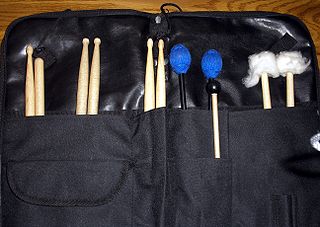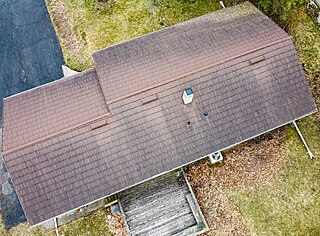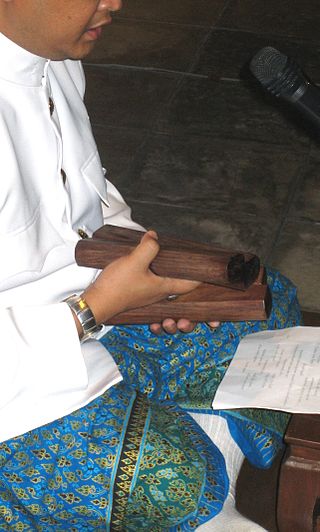
A ruler, sometimes called a rule, scale or a line gauge or meter stick, is an instrument used to make length measurements, whereby a length is read from a series of markings called "rules" along an edge of the device. Usually, the instrument is rigid and the edge itself is a straightedge, which additionally allows one to draw straighter lines.

A T-square is a technical drawing instrument used by draftsmen primarily as a guide for drawing horizontal lines on a drafting table. The instrument is named after its resemblance to the letter T, with a long shaft called the "blade" and a short shaft called the "stock" or "head". T-squares are available in a range of sizes, with common lengths being 18 inches (460 mm), 24 inches (610 mm), 30 inches (760 mm), 36 inches (910 mm) and 42 inches (1,100 mm).

A drill bit is a cutting tool used in a drill to remove material to create holes, almost always of circular cross-section. Drill bits come in many sizes and shapes and can create different kinds of holes in many different materials. In order to create holes drill bits are usually attached to a drill, which powers them to cut through the workpiece, typically by rotation. The drill will grasp the upper end of a bit called the shank in the chuck.

A tape measure or measuring tape is a flexible ruler used to measure length or distance.

A percussion mallet or beater is an object used to strike or beat a percussion instrument to produce its sound.

The Tinkertoy Construction Set—commonly known as Tinkertoy, Tinker Toy, or plural forms thereof—is a construction set for children. It was designed in 1914 and was originally manufactured in Evanston, Illinois, U.S. The brand is now owned by Hasbro.

The chain is a unit of length equal to 66 feet, used in both the US customary and Imperial unit systems. It is subdivided into 100 links. There are 10 chains in a furlong, and 80 chains in one statute mile. In metric terms, it is 20.1168 m long. By extension, chainage is the distance along a curved or straight survey line from a fixed commencing point, as given by an odometer.

Gunter's chain is a distance-measuring device used for surveying. It was designed and introduced in 1620 by English clergyman and mathematician Edmund Gunter (1581–1626). It enabled plots of land to be accurately surveyed and plotted, for legal and commercial purposes.

Wood shingles are thin, tapered pieces of wood primarily used to cover roofs and walls of buildings to protect them from the weather. Historically shingles, also known as shakes, were split from straight grained, knot free bolts of wood. Today shingles are mostly made by being cut which distinguishes them from shakes, which are made by being split out of a bolt.

Go equipment refers to the board, stones, and bowls for the stones required to play the game of Go. The quality and materials used in making Go equipment varies considerably, and the cost varies accordingly from economical to extremely expensive.
A lacrosse stick or crosse is used to play the sport of lacrosse. Players use the lacrosse stick to handle the ball and to strike or "check" opposing players' sticks, causing them to drop the ball. The head of a lacrosse stick is roughly triangular in shape and is strung with loose netting that allows the ball to be caught, carried, passed, or shot.

In field hockey, each player carries a stick and cannot take part in the game without it. The stick for an adult is usually in the range 89–95 cm (35–38 in) long. A maximum length of 105 cm (41.3") was stipulated from 2015. The maximum permitted weight is 737 grams. The majority of players use a stick in the range 19 oz to 22 oz. Traditionally hockey sticks were made of hickory, ash or mulberry wood with the head of the sticks being hand carved and therefore required skilled craftsmen to produce. Sticks made of wood continue to be made but the higher grade sticks are now manufactured from composite materials which were first permitted after 1992. These sticks usually contain a combination of fibreglass, aramid fiber and carbon fibre in varying proportions according to the characteristics required.

Tuckpointing is a way of using two contrasting colours of mortar in the mortar joints of brickwork, with one colour matching the bricks themselves to give an artificial impression that very fine joints have been made. In some parts of the United States and Canada, some confusion may result as the term is often used interchangeably with pointing and repointing.
A level staff, also called levelling rod, is a graduated wooden or aluminium rod, used with a levelling instrument to determine the difference in height between points or heights of points above a vertical datum. When used for stadiametric rangefinding, the level staff is called a stadia rod.

Fighter kites are kites used for the sport of kite fighting. Traditionally, most are small, unstable single-line flat kites where line tension alone is used for control, at least part of which is manja, typically glass-coated cotton strands, to cut down the line of others.
Fly fishing tackle comprises the fishing tackle or equipment typically used by fly anglers. Fly fishing tackle includes:

Listed here are the weapons of pencak silat. The most common are the machete, staff, kris, sickle, spear, and kerambit. Because Southeast Asian society was traditionally based around agriculture, many of these weapons were originally farming tools.

The krap is a Southeast Asian musical percussion instrument (clapper) used in Cambodia and Thai for percussion. The krap, made of bamboo, wood and metal, are used for dance rhythms and for song.

A regularhaircut in Western fashion is a men's and boys' hairstyle featuring hair long enough to comb on top, with a defined or deconstructed side part, and back and sides that vary in length from short, semi-short, medium, long, to extra long. The style is also known by other names including taper cut, regular taper cut, side-part and standard haircut; as well as short back and sides, business-man cut and professional cut, subject to varying national, regional, and local interpretations of the specific taper for the back and sides.
Tree height is the vertical distance between the base of the tree and the tip of the highest branch on the tree, and is difficult to measure accurately. It is not the same as the length of the trunk. If a tree is leaning, the trunk length may be greater than the height of the tree. The base of the tree is where the projection of the pith (center) of the tree intersects the existing supporting surface upon which the tree is growing or where the seed sprouted. If the tree is growing on the side of a cliff, the base of the tree is at the point where the pith would intersect the cliff side. Roots extending down from that point would not add to the height of the tree. On a slope this base point is considered as halfway between the ground level at the upper and lower sides of the tree. Tree height can be measured in a number of ways with varying degrees of accuracy.















